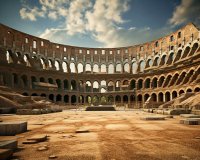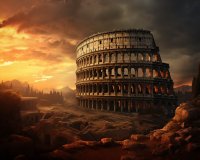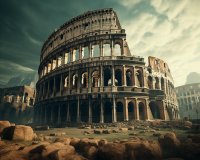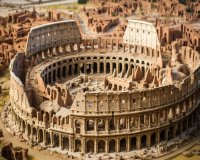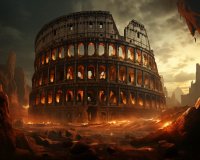In the Footsteps of Emperors: Tracing Rome’s Historical Landscape
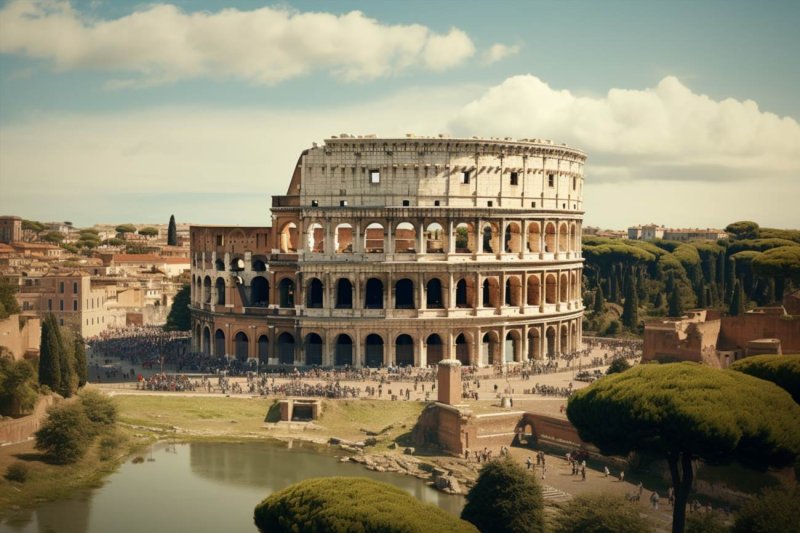
In the Footsteps of Emperors: Tracing Rome's Historical Landscape
Rome, the eternal city, is a living testament to the grandeur and power of ancient civilizations. Steeped in history, it is a city where the footsteps of emperors echo through time, leaving an indelible mark on its landscape.
The rich historical tapestry of Rome unfolds as you traverse its cobbled streets, adorned with remnants of a bygone era. The ruins of the Roman Forum, once the epicenter of political and social life, stand as silent witnesses to centuries of triumphs and trials.
Amidst the hustle and bustle of modern life, the Colosseum stands as a solemn reminder of Rome's prowess in engineering and entertainment. Its colossal structure beckons visitors to envision the roar of the crowd and the clash of gladiators in a display of raw strength and skill.
Vatican City, a sovereign state within Rome, encapsulates the spiritual essence of the city. St. Peter's Basilica, a masterpiece of Renaissance architecture, is a sanctuary of faith and art. The breathtaking beauty of Michelangelo's Pieta and the stunning grandeur of the Sistine Chapel ceiling evoke awe and reverence.
Rome's architecture narrates a story of evolving styles and influences. From the imposing Pantheon, a marvel of ancient Roman engineering, to the Baroque splendor of the Trevi Fountain, each edifice reflects a distinct epoch in the city's history.
Exploring the catacombs beneath Rome provides a glimpse into its early Christian history. These subterranean burial grounds bear witness to the spread of Christianity and the struggles faced by its adherents.
The Appian Way, an ancient Roman road, offers a fascinating journey through time. Walking in the footsteps of emperors along this historic thoroughfare, you can sense the echoes of chariots and the footsteps of soldiers.
As you wander through the Palatine Hill, where the emperors resided in opulent palaces, you can visualize the grand lifestyle of Rome's elite. The stunning views of the Roman Forum from this vantage point serve as a reminder of the city's glorious past.
In conclusion, Rome is a city where the past and present coalesce, inviting visitors to immerse themselves in a journey through the annals of history. The footsteps of emperors resonate in every corner, leaving an indelible mark on the landscape and our collective consciousness.
Rome: Colosseum and Roman Forum Ticket with Multimedia Video
Embark on an educational adventure with a tour of the most important sites in Rome — ideal for introducing you to the history of the city. Get preliminary information from a short multimedia video, and then set off on foot to see the Forum, Palatine Hill first and the Colosseum at the end of your visit.
Start your experience at the activity provider's office, where you'll pick up your tickets and enjoy a multimedia video about ancient Rome. With your ticket, discover the Archaeological Park: Roman Forum, Palatine Hill first, and the Colosseum.
See the Roman Forum where everyday Roman citizens used to live, see the tomb of emperor Julius Caesar, and explore the ancient ruins at your own pace.
Continue your visit with the Palatine Hill, the site of the foundation of Rome, and the settlement of the most important houses of emperors and kings. Located just feet away from the Roman Forum and Circus Maximum.
At the end, step inside one of the world's most famous monuments: the Colosseum.
The entrance to the Colosseum will be approximately 2 hours after the meeting point time. Explore the immense amphitheater — the largest ever built by the Roman Empire.
These tickets cannot be used for school groups, group guided tours, and private guided tours.
Includes:
- Entry ticket to the Roman Forum
- Entry ticket to the Palatine Hill
- Entry ticket to the Colosseum
- Assistance at the meeting point
- 30-minute ancient Rome multimedia video
- Paper city map
- WiFi
- Toilet lounge
Meeting point
This voucher is not your entrance ticket. Exchange your voucher at the Touristation office Piazza Ara Coeli, 16. If you are facing Vittorio Emanuele II monument, the office is on the right-hand side. We recommend taking any bus, tram, or walking route to Piazza Ara Coeli, 16 (next to Venezia square).
Important information
What to bring:
- Passport or ID card
- Passport or ID card for children
Not allowed:
- Pets
- Luggage or large bags
- Alcohol and drugs
- Sprays or Aerosols
- Glass objects
Know before you go:
- The time selected for your booking refers to the timing at the Touristation office
- The Roman Forum and the Palatine must be visited for approximately 2 hours, before entering the Colosseum
- Families with children will be escorted to the entrance of the Roman Forum
- These tickets cannot be used for school groups, group guided tours, and private guided tours
- The Colosseum ticket price is 17 EUR plus a 2 EUR reservation fee (included in this activity). The price difference is for other services
- Ticket price includes a supplement to raise funds for the emergency situation caused by the floods in Emilia Romagna as decided by Italian Government.
The Impact of Emperors on Rome
Rome, known for its rich history and unparalleled influence on Western civilization, was profoundly shaped by the emperors who ruled over it. The Roman Empire, often referred to as one of the greatest in history, saw a succession of emperors who each left their unique mark on the city and the world at large.
Emperors played a pivotal role in the governance, expansion, and transformation of Rome. This article explores the impact of emperors on Rome, from the early days of the Roman Republic to the zenith of the Roman Empire.
The Rise of the Roman Emperors
The transition from the Roman Republic to the Roman Empire was marked by the rise of emperors. Julius Caesar, while not technically an emperor, played a significant role in the shift of power. His assassination in 44 BCE paved the way for his adopted son, Octavian, who became the first Roman Emperor, taking the name Augustus. Augustus laid the foundation for the empire and consolidated his power, marking the beginning of a new era for Rome.
Augustus and the Pax Romana
Under Augustus's rule, Rome experienced a period of relative peace and stability known as the Pax Romana. This era, lasting for approximately two centuries, allowed the empire to flourish culturally, economically, and socially. Augustus' administrative reforms, military achievements, and focus on infrastructure development set the stage for a prosperous Rome.
The Architectural Legacy of Emperors
Rome is renowned for its architectural marvels, many of which were commissioned by emperors. One such example is the Colosseum, an iconic amphitheater built by Emperor Vespasian in 70-80 CE. This massive structure could accommodate over 50,000 spectators and was the site of grand gladiatorial contests and other public spectacles.
Another architectural wonder is the Pantheon, originally constructed by Marcus Agrippa during the reign of Augustus but rebuilt by Emperor Hadrian in the 2nd century CE. The Pantheon's dome, an engineering marvel, still stands as a testament to the architectural prowess of Roman emperors.
Emperors and Roman Expansion
Roman emperors played a significant role in expanding the empire's territories. Trajan, for instance, presided over one of the largest territorial expansions, including the annexation of Dacia (modern-day Romania). This expansion brought wealth and resources to Rome but also posed challenges in terms of administration and defense.
Emperors and Decline
While some emperors are celebrated for their contributions, others are notorious for their extravagance, tyranny, and mismanagement. Nero, for instance, is remembered for his lavish spending and persecution of Christians. The decline of the Roman Empire, often attributed to factors like economic instability, military defeats, and internal strife, can also be linked to the actions of certain emperors.
The End of an Era
The Roman Empire ultimately faced its demise in the 5th century CE. The last Roman Emperor, Romulus Augustulus, was deposed in 476 CE, marking the end of the Western Roman Empire. The Eastern Roman Empire, often referred to as the Byzantine Empire, continued for several more centuries, with Constantinople as its capital.
Conclusion
In conclusion, the emperors of Rome played a vital role in shaping the city and the empire's destiny. From Augustus and the Pax Romana to the grand architectural wonders, their impact on Rome is undeniable. The rise, reign, and, in some cases, the fall of these emperors left an indelible mark on the course of history and continue to be a source of fascination for historians and enthusiasts alike.
Rome: Colosseum Arena, Roman Forum, and Palatine Hill Tour
Embark on a captivating journey through Rome's historical wonders with the "Rome: Colosseum Arena, Roman Forum, and Palatine Hill Tour." Led by experienced guides, this immersive walking tour offers a unique perspective on the Colosseum, Roman Forum, and Palatine Hill, shedding light on the remarkable world of gladiators and ancient Roman engineering.
Explore the Colosseum, stepping onto its awe-inspiring arena floor, where the echoes of cheering crowds and the stories of fearless gladiators come to life. Delve into the training, living conditions, and the thrilling, yet brutal, games that took place within these iconic walls. Marvel at the ingenious engineering systems beneath the Colosseum's arena floor, which brought animals and gladiators into view seemingly from thin air.
Discover the magnificent triumphal arches dedicated to the mighty emperors Titus and Constantine, which stand as historical witnesses to the grandeur of the Roman Empire. Ascend Palatine Hill for breathtaking panoramic views of Rome's sprawling cityscape.
Experience this incredible journey in your preferred way, with options for private and group tours. Choose the ideal way to explore the Colosseum, Roman Forum, and Palatine Hill, immersing yourself in the rich history of Rome.
Highlights
- Step through the Gladiators’ Gate into the Colosseum, where history's deadliest battles took place.
- Learn about gladiators' lives, training, and living conditions, gaining a deeper understanding of their world.
- Explore the intricate engineering systems hidden beneath the Colosseum's arena floor.
- Admire the grand triumphal arches erected in honor of emperors Titus and Constantine.
- Climb Palatine Hill for mesmerizing views of the city below.
Join us for this exceptional tour to witness Rome's iconic landmarks and delve into its captivating history.
Includes
- Knowledgeable guide
- Guided walking tour
- Entrance to the Colosseum
- Access to the Colosseum’s arena floor
- Entrance to the Palatine Hill
- Entrance to the Roman Forum
- Headset for enhanced audio experience
Important Information:
Meeting Point: Meet your guide at the Arch of Constantine, located near the Piazza del Arco di Costantino. (Google Maps)
What to Bring:
- Passport or ID card
- Comfortable shoes
- Passport or ID card for children
Not Allowed:
- Pets
- Weapons or sharp objects
- Luggage or large bags
- Drones
- Selfie sticks
- Umbrellas
Additional Information:
Security measures similar to airport screening are in place for all visitors. Tour modifications may occur if the minimum participant count is not met.
The Architecture of Ancient Rome
Ancient Rome is renowned for its rich history, powerful empire, and lasting contributions to various fields. Among these significant contributions is the architectural marvel that defined the era. The architecture of Ancient Rome, characterized by its grandeur, engineering prowess, and enduring influence, continues to captivate the world.
Roman Architectural Styles
The architecture of Ancient Rome can be divided into several distinctive styles that evolved over the centuries. These styles include:
- Republican Architecture: The early Roman Republic primarily featured utilitarian structures, such as temples and public buildings. The Temple of Jupiter Optimus Maximus on the Capitoline Hill is a prime example of this period.
- Imperial Architecture: As the Roman Republic transitioned into the Roman Empire, the architectural style became grander and more monumental. Amphitheaters like the Colosseum and aqueducts such as the Pont du Gard are iconic examples of this era.
- Early Christian and Byzantine Architecture: After the adoption of Christianity, the architecture also evolved. The Basilica of Maxentius and the Hagia Sophia exemplify the blending of Roman and Byzantine styles.
Engineering Marvels
The Romans were revered for their engineering innovations, which enabled them to create remarkable architectural achievements. Some of the most notable engineering marvels of Ancient Rome include:
- Aqueducts: The Romans constructed an extensive network of aqueducts to supply clean water to cities. The aqueducts featured impressive arches, with the Pont du Gard in France being a stunning example of Roman aqueduct engineering.
- Roads: The Romans built an extensive road network that allowed for efficient transportation across their vast empire. The Appian Way, one of the earliest and most famous Roman roads, is still visible in parts of Italy.
- Arches and Domes: Roman architects perfected the use of arches and domes in their structures. The Pantheon in Rome is a prime example of a Roman dome, noted for its unique oculus.
- Concrete: The Romans developed a unique concrete formula that allowed them to construct enduring structures. The Roman concrete used in structures like the Colosseum has stood the test of time.
Monumental Buildings
The architecture of Ancient Rome is perhaps best exemplified by its monumental buildings, which continue to awe and inspire to this day:
| Structure |
Description |
| The Colosseum |
The Colosseum, an amphitheater in Rome, is an iconic symbol of Ancient Rome's architectural prowess. It could hold over 50,000 spectators and hosted various events, including gladiatorial contests. |
| The Pantheon |
The Pantheon is a temple in Rome renowned for its perfect spherical dome and the oculus in the center. It has served as a church for over a thousand years and showcases Roman engineering and design excellence. |
| The Roman Forum |
The Roman Forum was the heart of ancient Rome, a bustling public space filled with temples, basilicas, and other important buildings. It provides a glimpse into the daily life and politics of the time. |
| The Baths of Caracalla |
These vast public baths, built during the reign of Emperor Caracalla, were a place for relaxation and socializing. The complex featured stunning architecture and could accommodate thousands of bathers at once. |
Legacy and Influence
The architecture of Ancient Rome has left an indelible mark on the world. Even today, you can find Roman-inspired buildings and architectural elements in various parts of the globe. Roman architectural principles have influenced countless styles and movements, from Neoclassical to Renaissance to contemporary architecture. The enduring legacy of Ancient Roman architecture is a testament to the innovation and artistry of this remarkable civilization.
In conclusion, the architecture of Ancient Rome remains a source of fascination and admiration, with its monumental structures, engineering achievements, and lasting influence on the world of architecture. Exploring the remnants of Roman architecture is not only a journey through history but also an appreciation of the timeless beauty and ingenuity that continue to inspire us.


